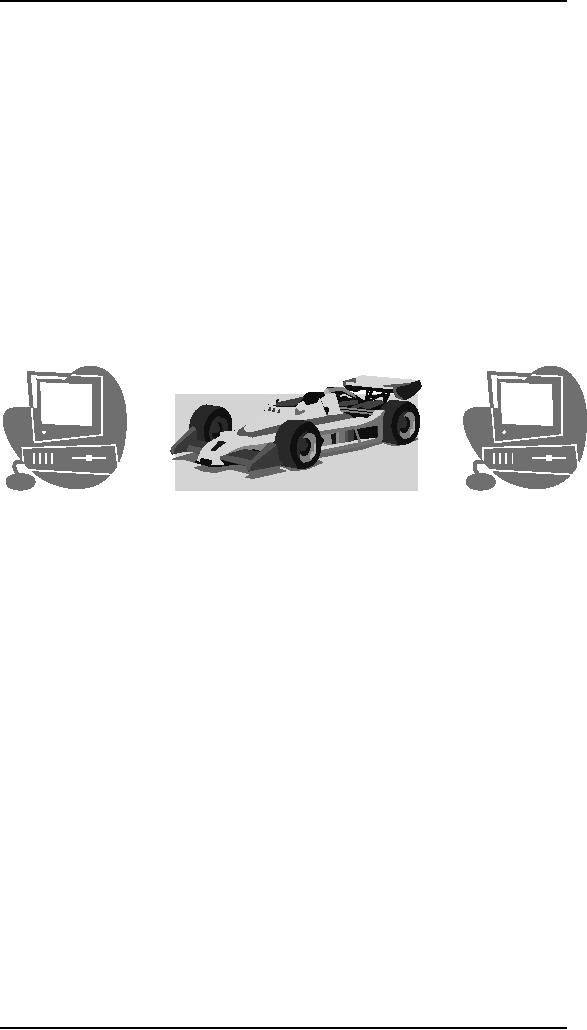 |
RIDDLES FOR THE INFORMATION AGE, ROLE OF HCI |
| << Table of Contents |
| DEFINITION OF HCI, REASONS OF NON-BRIGHT ASPECTS, SOFTWARE APARTHEID >> |

Human
Computer Interaction
(CS408)
VU
Lecture
1
Lecture 1.
Introduction
to
Human
Computer
Interaction Part I
Learning
Goals
As the
aim of this lecture is to
introduce you the study of
Human Computer
Interaction,
so that after studying this
you will be able to:
Answer
what is the significance of
Human Computer Interaction
(HCI)
Discuss
and argue about why
Human computer Interaction
(HCI) is important
with
reference
to the way in which
technology has developed
during past forty
years
Describe
a formal definition of
HCI.
At the
end of this lecture you will
be told about the course
contents. This will be a
brief
overview of the topics that
we will discuss in this course
and the structure of
the
course.
Run
for your lives---invasion
has begun---the computers
are invading.
Now it is
twenty first century and
during the past thirty years
technology has
advanced
to such an extent that
almost everyone come in
contact with computers in
one
way or another. Look around
yourself how many things
are there which
have
some
kind of computer embedded in them?
Think about a minute about
what you use
in a
typical day; ATM, cell
phone, VCR, remote control,
ticketing machine,
digital
personal
organizers, calculator, watch,
photocopier, toaster, bank, air
conditioner,
broadcasting,
satellite, microwave, medical
equipment, factories, companies....the
list
is
endless. Computers are
everywhere. We are surrounded by computers.
Now they
are part
of our everyday life.
Traditional
notion of computers is no more. Unlike in
the early days of
computing,
when
only highly skilled
technical people used
computers, nowadays the range
of
knowledge
and experience of different
users is very broad.
Computers are no more
just on
your table. Now computer
has become a tool of everyday
use. They are
everywhere,
at everyplace and in everything.
They are penetrating in
every aspect of
our
life. They are taking
our lives.
When
computers first appeared on the
commercial scene in the
1950s, they were
extremely
difficult to use, cumbersome and at
times unpredictable. There
were a
number of
reasons for this;
7

Human
Computer Interaction
(CS408)
VU
They
were very large and
expensive machines, so that by comparison
human labor
(that
is, 'people time') was an
inexpensive resource.
They
were used only by technical
specialists scientists and engineers
who were
familiar
with the intricacies of
off-line programming using
punch cards.
Little
was known about how to
make them easier to
use.
None of
these conditions holds
today: computers have become much
less expensive,
users
come from every walk of
life, and we understand a
great deal more about
how
to fit
the machines to people's needs
and their work.
Dramatic
decrease in the cost of
computing resources have
resulted from new
technological
advances, the most significant being
the development of the
silicon
chip.
The ability not only to
miniaturize circuits but
also to pack large number of
them
on to
tiny, individual chips paved
the way for his
development of powerful computers
with
large storage capacity. In less
than thirty years computers changed from
being
huge
machines housed in large, air-conditioned rooms to
much smaller machines,
including
some that can easily be
carried around by children.
Computers have also
become
more reliable and today's
machines do not suffer from
overheating like
their
ancestors.
Computing has entered a new
era and is becoming
ubiquitous.
The
development of the first
personal computers in the 1970s
was a major landmark
because
these machines provided interactive
computing power for
individual users at
low
cost. Consequently, instead of
just a handful of highly
experienced programmers
being
the only users, people
from all walks of life
commerce, farming, education,
retailing,
defense, manufacturing and entertainment
began using computer
systems.
Computers
are becoming increasingly
POWERFUL.
Computers
are performing more and more
TASKS. These changes in
technology have
opened up
a wide range of new possibilities
for the way in which
computers can be
used.
The sheer costliness and
time required to run
programs on the early
machines
dictated
the kinds of commercial
application in which computers
could be used.
Business
such as banking and
accounting, with large-scale
record keeping
activities,
were
the first to take up
computing technology. Companies
that were involved in
activities
with `fast' cycles, such as
transaction processing for airlines
and retailing,
could
not make use of these
machines. They were not
sufficiently fast or
responsive,
but
this is not a problem with
modern computers.
Computers
have also found a place in
many private homes. In fact,
such has been
their
pervasiveness that now just
about everyone, young or
old, able or
disabled,
skilled
or unskilled, is using or is directly
affected by computers in one way
or
another.
Machines are leaking into
every aspect of lives. So
now the concept of
life,
without
computer is same as concept of
life without electricity,
and obviously it is
hard to
live without light as well
as with computer!
Run
for your lives---invasion
has begun---the computers
are invading.
As
computers are penetrating in
our daily life, it has
some results. The bright
side of
this
invasion is:
Computers
are enabling new
discoveries
8

Human
Computer Interaction
(CS408)
VU
Leading
to efficiencies
Making
our life easy and
convenient
On the
not so bright side the
result is:
Computers
are annoying us
They
are infuriating us
They
even kill a few of
us.
In turn,
we will be tempted to kill our computers,
but we won't dare because we
are
already
utterly, irreversibly dependent on
these hopeful monsters that
make modern
life
possible. So we will have to think
about them. We will have to
think how we can
make
them better. We need to fundamentally
rethink how human and
machines
interact.
And rethink the relationship
in deep and novel ways, for
the fault for
our
burgeoning
problems lies not with
our machines, but with
us.
1.1
Riddles
for the Information
Age
What do you
get when you cross a
computer with an Airplane?
+
=
In
December 1995, American
Airlines Flight 965 departed
from Miami on a
regularly
scheduled
trip to Cali, Columbia. On
the landing approach, the
pilot of the 757
needed
to select
the next radio navigation
fix, named "ROZO". He entered an "R"
into his
navigation
computer. The computer
returned a list of nearby
navigation fixes
starting
with "R"
and the pilot selected the
first of these, whose latitude
and longitude
appeared to be
correct. Unfortunately, instead of
"ROZO", the pilot
selected
"ROMEO",
132 miles to the northeast.
The jet was southbound
descending into a
valley
that runs north-south, and
any lateral deviation was
dangerous. Following
indications
on the flight computer, the
pilots began an easterly turn
and slammed into
a granite
peak at 10,000 feet. One
hundred and fifty two
passengers and all
eight
crewmembers
aboard perished. Four
passengers survived with serious
injuries.
What do you
get when you cross a
computer with a Camera?
9

Human
Computer Interaction
(CS408)
VU
+
=
Here is a
riddle for the information
age: what do you get when
you cross a computer
with a
camera? Answer: A computer!
Thirty years ago, a 35mm
Pentax Model H, had
a small
battery in it that powered
the light meter. Like a
wristwatch battery, I
merely
swapped in a
new one every couple of
years. Fifteen years ago, an electronic
camera,
a 35mm
Canon T70, used two AA
batteries to power its
rather simple
exposure
computer
and its automatic film
drive. It had a simple
On/Off switch, so that
the
batteries
wouldn't wear down
needlessly.
Five
years ago, a first-generation digital
camera, had a similar On/Off
switch, but this
time it
had the smarts of a
rudimentary computer inside
it. So if I forgot to turn it
off,
it
automatically shut down after
one minute of
inactivity.
One
year ago, second-generation
digital camera, a Panasonic PalmCam,
had an even
smarter
computer chip inside it. It
was so smart that its On/Off
switch had evolved
into an
Off/Rec/Play switch. It now
had modes: it had to put
into Rec mode to
take
pictures
and Play mode to view
them on its small video
display.
The
newest camera, a Nikon CoolPix
900, is a third-generation digital
camera and the
smartest
yet. In fact, it has a
full-blown computer that
displays a Windows-like
hourglass
while it "boots up". Like
some mutant fish with
extra heads, its
On/Off
switch
has now grown to have
four settings: Off/ARec/MRec/Play.
"ARec" means
"automatic
record" and "MRec" means
"manual record." as far as I
can figure out
how to
turn it on without a lengthy
explanation.
The
new camera is very
power-hungry, and its
engineers thoughtfully provided it
with
a
sophisticated computer program
that manages the consumption
of battery power. A
typical
scenario goes like this: I
turn the evil off/etc.
switch to "MRec," wait
about
seven
long seconds for the
camera to boot up, then
point it at my subject. I aim
the
camera
and zoom in to properly
frame the image. Just as I'm
about to press the
shutter
button,
the camera suddenly realizes
that simultaneously running
the zoom, charging
the
flash, and energizing the
display has caused it to run
out of power. In
self-defense,
it
suspends its ability to
actually take pictures. But
I don't know that because
I'm
liking
through the viewfinder,
waving my arms and saying
"Smile" and pressing
the
shutter
button. The computer detects
the button press, but it
simply cannot obey. In
a
misguided
effort to help out, the
power management program instantly takes
over and
makes an
executive decision: shed
load. It shuts down the
power-greedy LCD
video
display.
I look at the camera
quizzically, wondering why it
didn't take the
picture,
shrug my
shoulders, and let my arm
holding the camera drop to
my side. But as soon
as the
LCD is turned off, there is
more battery power available
for other systems.
The
power
management program senses this increase
and realizes that it now
has enough
electricity
to take pictures. It now
returns control to the
camera program, which
is
10

Human
Computer Interaction
(CS408)
VU
waiting
patiently to process the
command it received when I
pressed the shutter
button,
and it takes a nicely auto-focused,
well-exposed, high-resolution
digital
picture
of my kneecap.
That
old mechanical Pentax had
manual focusing, manual
exposure, and manual
shutter-speed,
yet it was far less
frustrating to use than the
fully computerized
modern
Nikon
CoolPix 900, which has
automatic focusing, exposure,
and shutter-speed.
Camera
may still take pictures,
but it behaves like a computer
instead of a camera.
What do you
get when you cross a
computer with an alarm
clock?
+
=
A
computer! I just purchased an expensive
new clock-radio for my
bedroom, a JVC
FS-2000.
It has a very sophisticated
computer brain, and offers
high fidelity,
digital
sound,
and lots of features. It
wakes me up at a preset time by playing a
compact disc,
and it
has the delicacy and
intelligence to slowly fade up
the volume when it begins
to
play at
six o'clock in the morning.
This feature is really
pleasant and quite
unique,
and it
compensates for the fact
that I want to hurl the
infuriating machine out
the
window.
It's
very hard to tell when
the alarm is armed, so it
occasionally fails to wake me
up
on a
Monday and rousts me out of
bed early on a Saturday. Sure, it
has an indicator to
show
the alarm is set, but
that doesn't mean it's
useful. The clock has a
sophisticated
alphanumeric
liquid crystal display (LCD)
that displays all of its
many functions. The
presence
of a small symbol in the
upper left corner of the
LCD indicates the alarm
is
armed,
but in a dimly lit bedroom
the clock symbol visible,
but the backlight
comes
on when
the CD or radio is explicitly
turned on. There's a gotcha,
however, as the
alarm
simply won't ever sound
while the CD is explicitly
left on, regardless of
the
setting
of the alarm. It is this
paradoxical operation that
frequently catches me
unaware.
It is
simple to disarm the alarm:
Simply press the "Alarm"
button once, and the
clock
symbol
disappears from the display.
However to arm it, I must
press the "Alarm"
button
exactly five times. The
first time I press it,
the display shows me the
time of
the
alarm. On press tow, it
shows the time when it will
turn the sound off. On
press
three, it
shows me whether it will play
the radio or the CD. On
press four, it shows
me
the
preset volume. On press
five, it returns to the
normal view, but with
the alarm now
armed.
But with just one
additional press, it disarms the
alarm. Sleepy, in a
dark
bedroom,
it is quite difficult to perform
this little digital ballet
correctly. The alarm
clock
may still wake me up,
but it behaves like a
computer.
11

Human
Computer Interaction
(CS408)
VU
By
contrast, my old non-computerized
alarm clock woke me up with
a sudden, unholy
buzzing.
When it was armed, a single
red light glowed. When it
was not armed,
the
red
light was dark. I didn't
like this old alarm
clock for many reasons,
but at least I
could
tell when it was going to
wake me up.
Because
it is far cheaper for manufacturers to
use computers to control the
internal
functioning
of devices than it is to use
older, mechanical methods, it is
economically
inevitable
that computers will insinuate themselves
into every product and
service in
our
lives. This means that
the behavior of all of our
products will be the same as
most
obnoxious
computers, unless we try
some thing different.
What do you
get when you cross a
computer with a car?
+
=
A
computer! Porsche's beautiful new
high-tech spots car, the
Boxster, has seven
computers in it to
help manage its complex
systems. One of them is
dedicated to
managing
the engine. It has special
procedures built into it to deal
with abnormal
situations.
Unfortunately, these sometimes backfire.
In some early models, if the
fuel
level in
the gas tank got
very low---only a gallon or so
remaining---the centrifugal
force of
a sharp turn could cause the
fuel to collect in the side
of the tank, allowing
air
to enter
the fuel lines. The
computer sensed this as a
dramatic change in the in
coming
fuel
mixture, and interpreted it as a
catastrophic failure of the
injection system. To
prevent
damage, the computer would shut
down the ignition and stop
the car. Also to
prevent
damage, the computer would
not let the driver restart
the engine until the
car
had been
towed to a shock and
serviced
When
owners of early Boxsters
first discovered this
problem, the only
solution
Porsche
could devise was to tell
them to open the engine
compartment and
disconnect
the
battery for at least five
minutes, giving the computer
time to forget all
knowledge
of the
hiccup. The sports car may
still speed down those
too-lane black top roads,
but
now, in
those turns, it behaves like a
computer.
What do you
get when you cross a
computer with a warship?
12

Human
Computer Interaction
(CS408)
VU
+
=
In September of
1997, while conducting fleet
maneuvers in the Atlantic, the
USS
Yorktown,
one of the Navy's new
Aegis guided-missile cruisers, stopped
dead in the
water. A
Navy technician, while
calibrating an on-board fuel
valve, entered a zero
into
one of the shipboard management
computers, a Pentium Pro running
Windows
NT.
The program attempted to
divide another number by
that zero---a
mathematically
undefined
operation---which resulted in a complete
crash of the entire
shipboard
control
system. Without the
computers, the engine halted
and the ship sat
wallowing
in the
swells for two hours
and fifty-five minutes until
it could be towed into
port.
Good
thing it wasn't in a war
zone.
What do
you get when you
cross a computer with a
warship? Admiral Nimitz
is
rolling
in his grave! Despite this
setback, the Navy is committed to
computerizing all
of its
ships because of the manpower
cost savings, and so deflect
criticism of this
plan, it
has blamed the "incident" on
human error. Because the
software creation
process
is out of control, the
high-tech industry must either
bring its process to heel
or
it will
continue to put the blame on
ordinary users while
ever-bigger machines sit
dead in
the water
So here
you saw the result of
integrating computers in our lives. As I
said early,
computers will
annoy us, infuriate us,
and even kill a few of us.
In turn, we will be
tempted
to kill our computers, but we
won't dare because we are already
utterly,
irreversibly
dependent on these hopeful monsters
that make modern life
possible. So
we will
have to think about them. We
will have to think how we
can make them
better.
We need to fundamentally rethink how
human and machines interact.
And
rethink
the relationship in deep and
novel ways, for the
fault for our
burgeoning
problems
lies not with our machines,
but with us.
1.2
Role of
HCI
Here
comes the role of HCI.
Human designed the
interfaces we hate; human
continue
to use
dysfunctional machines even as the
awkward interfaces strain
their eyes, ache
their
backs, and ruin their wrist
tendons. HCI plays a role to
bridge up the gape
between
the interfaces of machines and
human understanding that we
have seen in the
previous
examples.
Definition
of HCI
"Human-Computer
Interaction is a discipline concerned
with the design,
evaluation
and
implementation of interactive computing
systems for human use
and with the
study of
major phenomena surrounding
them"
-ACM/IEEE
13
Table of Contents:
- RIDDLES FOR THE INFORMATION AGE, ROLE OF HCI
- DEFINITION OF HCI, REASONS OF NON-BRIGHT ASPECTS, SOFTWARE APARTHEID
- AN INDUSTRY IN DENIAL, SUCCESS CRITERIA IN THE NEW ECONOMY
- GOALS & EVOLUTION OF HUMAN COMPUTER INTERACTION
- DISCIPLINE OF HUMAN COMPUTER INTERACTION
- COGNITIVE FRAMEWORKS: MODES OF COGNITION, HUMAN PROCESSOR MODEL, GOMS
- HUMAN INPUT-OUTPUT CHANNELS, VISUAL PERCEPTION
- COLOR THEORY, STEREOPSIS, READING, HEARING, TOUCH, MOVEMENT
- COGNITIVE PROCESS: ATTENTION, MEMORY, REVISED MEMORY MODEL
- COGNITIVE PROCESSES: LEARNING, READING, SPEAKING, LISTENING, PROBLEM SOLVING, PLANNING, REASONING, DECISION-MAKING
- THE PSYCHOLOGY OF ACTIONS: MENTAL MODEL, ERRORS
- DESIGN PRINCIPLES:
- THE COMPUTER: INPUT DEVICES, TEXT ENTRY DEVICES, POSITIONING, POINTING AND DRAWING
- INTERACTION: THE TERMS OF INTERACTION, DONALD NORMAN’S MODEL
- INTERACTION PARADIGMS: THE WIMP INTERFACES, INTERACTION PARADIGMS
- HCI PROCESS AND MODELS
- HCI PROCESS AND METHODOLOGIES: LIFECYCLE MODELS IN HCI
- GOAL-DIRECTED DESIGN METHODOLOGIES: A PROCESS OVERVIEW, TYPES OF USERS
- USER RESEARCH: TYPES OF QUALITATIVE RESEARCH, ETHNOGRAPHIC INTERVIEWS
- USER-CENTERED APPROACH, ETHNOGRAPHY FRAMEWORK
- USER RESEARCH IN DEPTH
- USER MODELING: PERSONAS, GOALS, CONSTRUCTING PERSONAS
- REQUIREMENTS: NARRATIVE AS A DESIGN TOOL, ENVISIONING SOLUTIONS WITH PERSONA-BASED DESIGN
- FRAMEWORK AND REFINEMENTS: DEFINING THE INTERACTION FRAMEWORK, PROTOTYPING
- DESIGN SYNTHESIS: INTERACTION DESIGN PRINCIPLES, PATTERNS, IMPERATIVES
- BEHAVIOR & FORM: SOFTWARE POSTURE, POSTURES FOR THE DESKTOP
- POSTURES FOR THE WEB, WEB PORTALS, POSTURES FOR OTHER PLATFORMS, FLOW AND TRANSPARENCY, ORCHESTRATION
- BEHAVIOR & FORM: ELIMINATING EXCISE, NAVIGATION AND INFLECTION
- EVALUATION PARADIGMS AND TECHNIQUES
- DECIDE: A FRAMEWORK TO GUIDE EVALUATION
- EVALUATION
- EVALUATION: SCENE FROM A MALL, WEB NAVIGATION
- EVALUATION: TRY THE TRUNK TEST
- EVALUATION – PART VI
- THE RELATIONSHIP BETWEEN EVALUATION AND USABILITY
- BEHAVIOR & FORM: UNDERSTANDING UNDO, TYPES AND VARIANTS, INCREMENTAL AND PROCEDURAL ACTIONS
- UNIFIED DOCUMENT MANAGEMENT, CREATING A MILESTONE COPY OF THE DOCUMENT
- DESIGNING LOOK AND FEEL, PRINCIPLES OF VISUAL INTERFACE DESIGN
- PRINCIPLES OF VISUAL INFORMATION DESIGN, USE OF TEXT AND COLOR IN VISUAL INTERFACES
- OBSERVING USER: WHAT AND WHEN HOW TO OBSERVE, DATA COLLECTION
- ASKING USERS: INTERVIEWS, QUESTIONNAIRES, WALKTHROUGHS
- COMMUNICATING USERS: ELIMINATING ERRORS, POSITIVE FEEDBACK, NOTIFYING AND CONFIRMING
- INFORMATION RETRIEVAL: AUDIBLE FEEDBACK, OTHER COMMUNICATION WITH USERS, IMPROVING DATA RETRIEVAL
- EMERGING PARADIGMS, ACCESSIBILITY
- WEARABLE COMPUTING, TANGIBLE BITS, ATTENTIVE ENVIRONMENTS